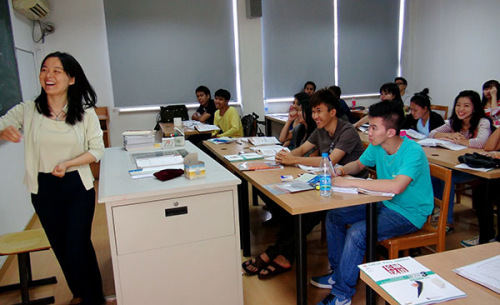
Undergraduates from Soochow University in Laos have classes in China. (Provided to China Daily)
Struggle for balance
But reality is never so simple.
Apart from the competition from the programs of Western schools, Chinese university branches and programs also struggle to maintain financial balance.
Liu, head of the Thai business school, said their courses are taught in Chinese and Thai languages, but now they find it hard to keep courses taught in Chinese going because of the high cost.
"It's expensive either to send our Chinese teachers to Bangkok or to hire local teachers who can teach in Chinese. We tried to keep the courses, but I'm afraid they won't last long," he said.
Soochow University in Laos, which currently rents a space in a hotel for classes, will complete its first phase of campus construction by April 2016, also has concerns about income and expenses.
Wang said the construction area for the first phase is 6,000 square-meters, which is enough for about 300 students.
"But according to our calculations, the budget will only be balanced when at least 1,000 students are enrolled," he said, adding that they charge each student $1,500 for tuition per year.
Increasing the number of students is not easy, said Wang Ruifang, head of China's Xiamen University in Malaysia, which started construction in Kuala Lumpur last summer.
He said that in Malaysia, schools like his must chase students, in the hope that they will choose Xiamen out of a crowded field of schools. "To lure students, we have to improve every aspect of our school and increase its attractiveness," he added.
But the universities are working to solve these problems. Wang Jiexian said that Soochow University cooperated with domestic enterprises in China, including Pioneer Wood Corp, a materials company in East China's Jiangsu province where Soochow is based, to obtain a donation to support the construction of the university's campus in Laos.
Teacher shortage
Running branches and programs overseas means that teachers should be able to teach in both Chinese and the local language, but the number of bilingual teachers is far from adequate, said Yan, the Chinese education official.
Wang Ruifang said teachers at Xiamen University in Malaysia now can teach in Chinese and English languages, but their number is still insufficient and should be increased.
Liu Ersi, head of Bangkok Business School, said the school faces a risk of brain drain, as some bilingual teachers from China are recruited by other educational institutions in Thailand.
"It's a loss for us because we made painstaking efforts to bring these teachers overseas. But they didn't stay," he said.
Wang Jiexian of Soochow in Laos said the university is planning to introduce a localization policy to solve this problem.
"We plan to select some of the best Laotian students at our universities and offer them the chance to study the Chinese language and earn postgraduate degrees in China. And then we will recruit them as teachers for our university in Laos," he said.


















































